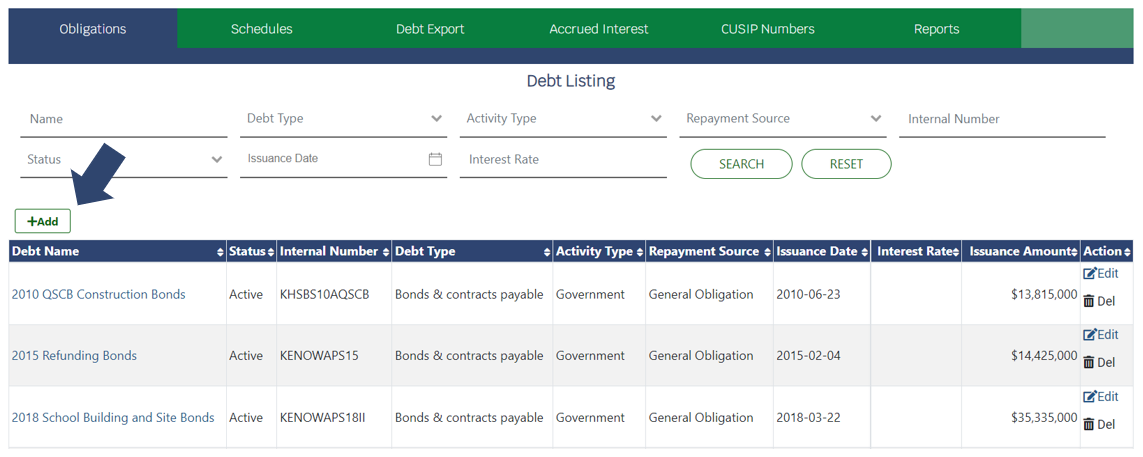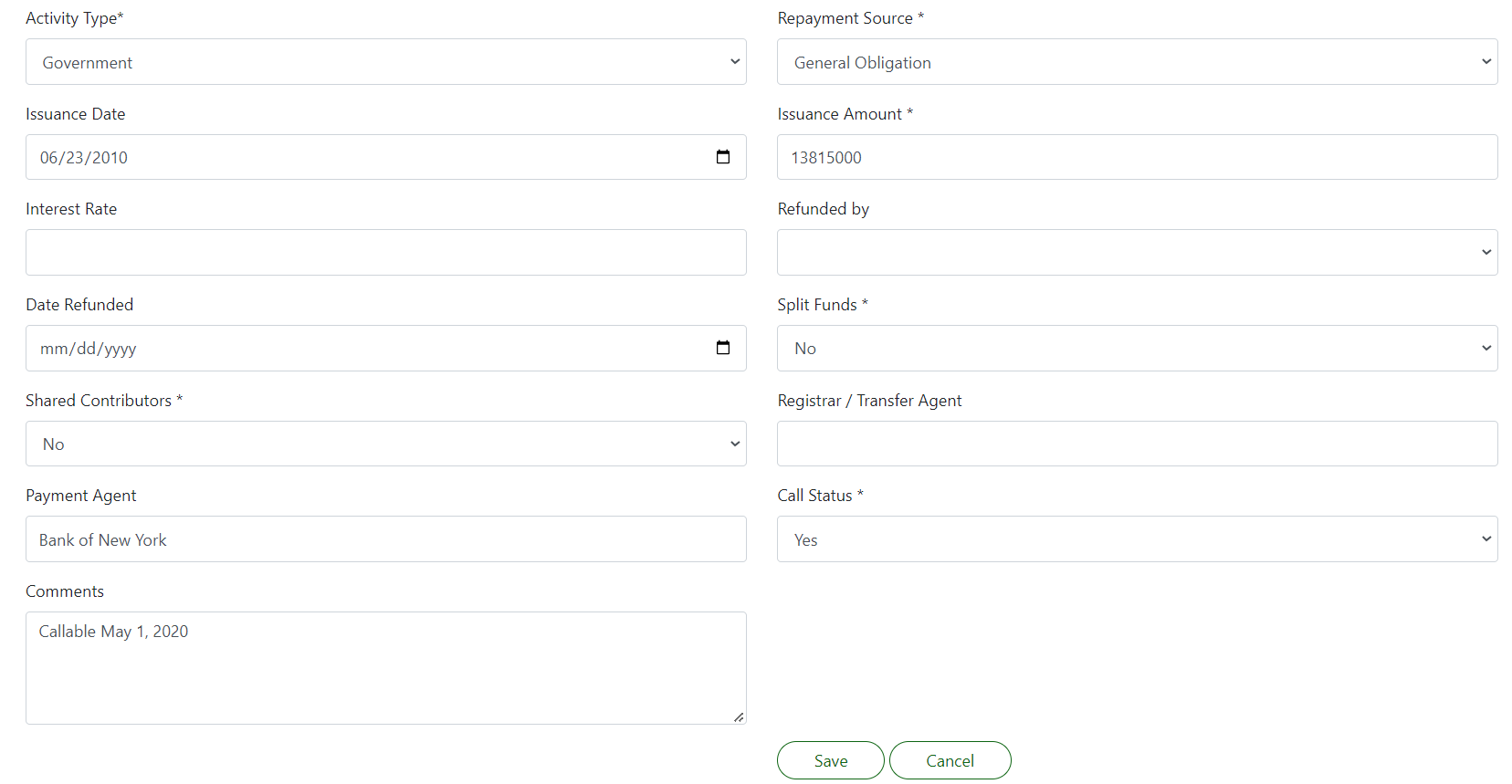This article provides detailed step-by-step directions for creating/managing debt obligations and schedules in the Munetrix Debt Manager.
⏰ Estimated Time: 5 minutes
Add a New Debt Obligation
The first step in creating a new debt obligation is to add the debt header record for the obligation. The debt header record stores information that applies to the obligation itself and not a specific payment record (debt schedule) which will be enter after the debt header record is created.
When entering debt obligations, you will find there are two distinct types of obligations; Employee Accrued Compensation (EAC) and all others. Employee Accrued Compensation are compensated absences are absences for which employees will be paid, such as vacation, sick leave, and sabbatical leave. Vacation leave and other compensated absences with similar characteristics should be accrued as a liability as the benefits are earned by the employees if the leave is attributable to past service and it is probable that the employer will compensate the employees for the benefits through paid time off or some other means, such as cash payments at termination or retirement (GASB Summary Statement No. 16). The type of information entered for EAC’s and the reporting format will differ from the other types of obligations.
- In the Obligations section, click Add. This will generate a new Debt Header record.

It is helpful to complete as many fields as possible in the Debt Header record. This information is usually found in various sections of the debt obligation schedule but may be available from other sources as well. The record screen may contain more fields than information is available for in a particular obligation. Required fields must be completed and are denoted by a (*).

- Debt Name*: This is the local or internal debt obligation name the district wishes to use. It could also be the official name - especially if you wish to use the public transparency reporting features.
- Official Name: The official name of the debt obligation on the bond or loan certificate. It may also appear on the debt schedule document.
- Status*: The Status field is provided to determine if an obligation should be included in transparency reports. By default, an obligation will be added with the status of Active. Changing the status to Retired permits you to keep the obligation in the Munetrix database but eliminate it from transparency reports like the “Long-term Debt Detail report”.
- Series: Some debt obligations will be part of a series of obligations to reach a desired goal or outcome. A bond ladder consists of a series of bonds (debt obligations), each with a different interest rate and maturity date. As each rung on the ladder matures, the principal is reinvested into a new bond.
- Purpose: The purpose field is where the school district can document the reason they are incurring the debt obligation. For example, working to eliminate a fiscal deficit, building a new school facility building, etc.
- Internal Number: This is a number or identifying code that you have generated internally to identify each obligation as opposed to an official number that the bond market or agent may have generated.
- CUSIP Number: A CUSIP number is a unique identification number assigned to stocks and registered bonds in the United States and Canada. It comprises nine letters and includes letters and numbers.
- Default Fund: This is an optional field unless you choose to report your obligation amounts by specific fund and/or you utilize the split fund feature. The split fund feature permits you to enter one payment schedule but split the results on reports by percentage. In this case, obligations that are not split will need to have a single fund entered in this field. In order to see Funds in the dropdown, you will need to enter your specific funds.
- Fund Number: The Fund Number field is optional but allows for the storage of the chart of accounts fund number to which this obligation is recorded.
- Debt Type*: Some transparency compliance requirements ask that the debt be reported by type of debt; for example, Bonds as opposed to Bank Loans. The Debt Type field gives you the opportunity to identify the type of debt being entered. You will be provided a drop down list of choices for the Debt Type entry.

- Activity Type*: GASB requires debt to be reported by Fund Type. For this reporting you identify Governmental Activity debt separate from Business Type (Enterprise) or Component Unit debt. You will be provided a drop down list of choices for the Activity Type entry.
- Repayment Source*: An important factor in a bond’s credit quality is the source of repayment for the bond. There are three main sources of repayment, and bonds are classified by these sources
- General Obligation – A general obligation bond is paid through any revenues the issuer receives. This type of bond is also sometimes known as a “full faith and credit” bond. The issuer has agreed to levy taxes in an amount sufficient to make payments of principal and interest on outstanding bonds.
- Revenue Bond – A revenue bond is repaid from the revenues of the project or system that the bond is financing rather than the municipal government’s general funds.
- Tax-Backed – A tax-backed bond is repaid from certain tax revenues.
- For more information visit the website of the Municipal Securities Rulemaking Board
- Issuance Date: This is the date the debt obligation was issued. This will appear on the debt schedule.
- Issuance Amount*: This is the total amount of the debt obligation. This will be listed on the debt schedule.
- Interest Rate: Interest rates may be fixed for the duration of the debt or may change from year to year. The Interest Rate field in the debt header record is a place to store either the fixed rate for the debt or a range of rates for the duration of the payment schedule. This is a text field and will is not limited to numbers. You will be given the opportunity to enter interest rates by date when you enter the payment schedule for the debt.
- Refunded By: If this obligation was refunded you can link this obligation to the obligation that was used to refund the original.
- Date Refunded: This is the date that the refunding debt obligation begins.
- Split Funds*: Sometimes the total debt obligation is split between two or more investment vehicles. If this is the case, select Yes. If not, select No.
- Shared Contributors*: Sometimes a debt obligation is split between two or more finance institutions. Select Yes if applicable or No if not applicable.
- Registrar/Transfer Agent: This is the institution responsible for keeping records of bondholders and shareholders after an issuer offers securities to the public.
- Payment Agent: A payment agent accepts payments from the issuer of a security and then distributes these funds to holders of the security. Although payment agents work with all securities, including stocks, they are widely used with debt instruments, like bonds.
- Call Status*: Callable or redeemable bonds are debt obligations that can be redeemed or paid off by the issuer prior to the bond's maturity date.
- Comments: Area to enter any comments or internal notes for the school district or users. This is a great place for notes if a debt obligation was refunded
After entering as much information as possible, click Save.
